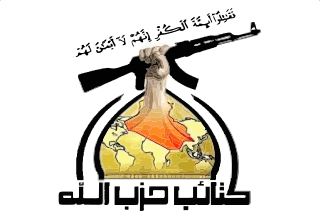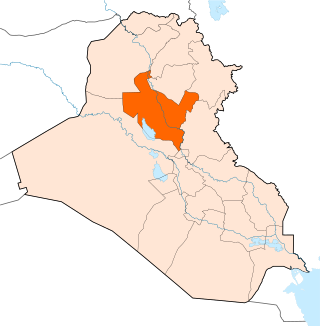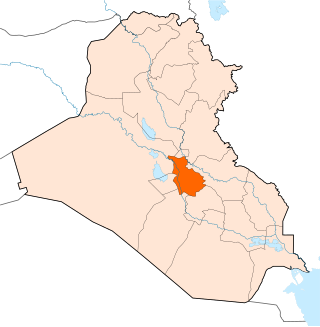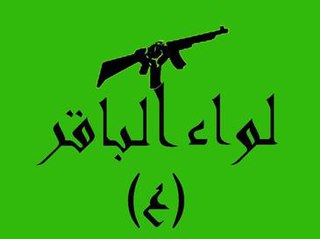
The Quds Force is one of five branches of Iran's Islamic Revolutionary Guard Corps (IRGC) specializing in unconventional warfare and military intelligence operations. U.S. Army's Iraq War General Stanley McChrystal describes the Quds Force as an organization analogous to a combination of the CIA and the Joint Special Operations Command (JSOC) in the United States. Responsible for extraterritorial operations, the Quds Force supports non-state actors in many countries, including Hezbollah, Hamas, Palestinian Islamic Jihad, the Houthi movement, and Shia militias in Iraq, Syria, and Afghanistan. According to Michael Wigginton et al., the Al-Quds Force is "a classic example of state-sponsored terrorism."

Qasem Soleimani was an Iranian military officer who served in the Islamic Revolutionary Guard Corps (IRGC). From 1998 until his assassination by the United States in 2020, he was the commander of the Quds Force, an IRGC division primarily responsible for extraterritorial and clandestine military operations, and played a key role in the Syrian Civil War through securing Russian intervention. He was described as "the single most powerful operative in the Middle East" and a "genius of asymmetric warfare." Former Mossad director Yossi Cohen said Soleimani's strategies had "personally tightened a noose around Israel's neck."
Special Groups (SGs) is a designation given by the United States military to the cell-based Shi'a paramilitary organizations operating within Iraq, According to the United States these groups are funded, trained, and armed by the Iranian Quds Force, part of the Islamic Revolutionary Guard Corps (IRGC).

Kata'ib Hezbollah, also known as the Hezbollah Brigades, is a radical Iraqi Shiite paramilitary group which is a part of the Iraqi Popular Mobilization Forces (PMF), staffing the 45th, 46th, and 47th Brigades. During the Iraq War (2003–11), the group fought against Coalition forces. It has been active in the War in Iraq (2013–2017) and the Syrian Civil War. The group was commanded by Abu Mahdi al-Muhandis until he was killed in a US drone attack in 2020. Thereafter, Abdul Aziz al-Muhammadawi became the new leader of the PMF. The group seeks to establish an Iran-aligned government in Iraq, expel American forces from the country, and advance the regional and international interests of Iran in Iraq and the region. The group is responsible for killing hundreds of U.S. soldiers and takes a central part in carrying out attacks against U.S. targets in Iraq and acts as part of the Axis of Resistance. Kata'ib Hezbollah has received extensive training, funding, logistic support, weapons, and intelligence from the IRGC's overseas military-intelligence service Quds Force.

The Islamic Republic of Iran and the Syrian Arab Republic are close strategic allies, and Iran has provided significant support for the Syrian government in the Syrian civil war, including logistical, technical and financial support, as well as training and some combat troops. Iran sees the survival of the Syrian government as being crucial to its regional interests. When the uprising developed into the Syrian Civil War, there were increasing reports of Iranian military support, and of Iranian training of the National Defence Forces both in Syria and Iran. From late 2011 and early 2012, Iran's IRGC began sending tens of thousands of Iranian troops and foreign paramilitary volunteers in coordination with the Syrian government to prevent the collapse of the Syrian Arab Army; thereby polarising the conflict along sectarian lines.

The Northern Iraq offensive began on 4 June 2014, when the Islamic State of Iraq and Levant, assisted by various insurgent groups in the region, began a major offensive from its territory in Syria into Iraq against Iraqi and Kurdish forces, following earlier clashes that had begun in December 2013 involving guerillas.

The departure of US troops from Iraq in 2011 ended the period of occupation that had begun with the U.S.-led invasion in March 2003. The time since U.S. withdrawal has been marked by a renewed Iraqi insurgency and by a spillover of the Syrian civil war into Iraq. By 2013, the insurgency escalated into a renewed war, the central government of Iraq being opposed by ISIL and various factions, primarily radical Sunni forces during the early phase of the conflict. The war ended in 2017 with an Iraqi government and allied victory, however ISIL continues a low-intensity insurgency in remote parts of the country.

The siege of Amirli was a siege of the predominantly Shi'ite Turkmen town of Amirli in Iraq by the Islamic State of Iraq and the Levant (ISIL) during the War in Iraq. The town was besieged by ISIL forces for 50 days from June 2014, lacking access to food, electricity, and water. Most of the residents are Shia Turkmen, who had organized local self-defense militias to fight against ISIL. On August 31, the Iraqi military reportedly broke the siege and entered the town. It has been described as "Iraq's biggest victory against ISIS", as of September 2014.

On 15 June 2014 U.S. President Barack Obama ordered United States forces to be dispatched in response to the Northern Iraq offensive of the Islamic State (IS), as part of Operation Inherent Resolve. At the invitation of the Iraqi government, American troops went to assess Iraqi forces and the threat posed by ISIL.

Liberation of Jurf Al Sakhar, codenamed Operation Ashura, was a two-day military operation by Iraqi government forces and Iranian-backed PMU forces beginning on 24 October 2014, aimed at retaking the strategic city of Jurf Al Sakhar near Baghdad from ISIL. The operation was mainly aimed at preventing ISIS militants from reaching the holy cities of Karbala and Najaf, where ISIS threatened to carry out attacks against the millions of Shia visitors commemorating the Day of Ashura.

The Second Battle of Tikrit was a battle in which Iraqi Security Forces recaptured the city of Tikrit from the Islamic State of Iraq and the Levant (ISIL). Iraqi forces consisted of the Iraqi Army and the Popular Mobilization Forces, receiving assistance from Iran's Quds Force officers on the ground, and air support from the American, British, and French air forces.

The Salahuddin Campaign was a military conflict in the Saladin Governorate, located in north-central Iraq, involving various factions fighting against a single common enemy, the Islamic State of Iraq and the Levant. The province exited Iraqi government control during ISIL's Northern Iraq offensive when large swathes of the north of the country were captured by the militant group with the Iraqi national army quickly disintegrating in the path of its advance. In light of the sweeping gains of the militants, Nouri Al-Maliki, the Prime Minister of Iraq at that time, attempted to declare a state of emergency though the Iraqi Parliament blocked his efforts to do so.

The Popular Mobilization Forces (PMF), also known as the Popular Mobilization Units (PMU), is an Iraqi state-sponsored paramilitary network composed of about 67 armed factions of primarily Iranian-backed Shi'ite groups, but also include Sunni Muslim, Christian, and Yazidi groups. The PMF were formed in 2014 and fought in nearly every major battle during the War in Iraq (2013-17) against Islamic State. Many of its main militias that belong to the Shia faction, trace their origins to the "Special Groups", Iranian-sponsored Shi'ite groups that previously fought in the Iraqi insurgency against the United States and the Coalition forces, as well as a sectarian conflict against Sunni Jihadist and Ba'athist insurgents. It has been labeled the new Iraqi Republican Guard after it was fully reorganized in early 2018 by its then-Commander Haider al-Abadi, Prime Minister of Iraq from 2014 to 2018, who issued "regulations to adapt the situation of the Popular Mobilization fighters".

Jamal Ja'far Muhammad Ali Al Ibrahim, known by the kunyaAbu Mahdi al-Muhandis was an Iraqi commander of the Popular Mobilization Forces (PMF). At the time of his death, he was deputy chief of the PMF and regarded as one of Iraq's most powerful men.
Iran is an opponent of Islamic State of Iraq and the Levant (ISIL), fighting the group in Syria and Iraq.

Harakat Hezbollah al-Nujaba, officially the 12th Brigade, is a radical Iraqi Shi'ite paramilitary group that is especially active in Syria and Iraq. It was established in 2013 by Akram al-Kaabi to support Bashar al-Assad in Syria against Islamist rebels. The group is supported by the IRGC's Quds Force, which provides the funding, weapons, and training of its members.

The Russia–Syria–Iran–Iraq coalition, also referred to as 4+1, is a joint intelligence-sharing cooperation between opponents of the Islamic State (IS) with operation rooms in Syria's Damascus and Iraq's Green Zone in Baghdad. It was formed as a consequence of an agreement reached at the end of September 2015 between Russia, the Islamic Republic of Iran, Iraq and the Syrian Arab Republic to "help and cooperate in collecting information about the terrorist Daesh group" (ISIL) with a view to combatting the advances of the group, according to the statement issued by the Iraqi Joint Operations Command. The statement also cited "the increasing concern from Russia about thousands of Russian terrorists committing criminal acts within ISIS."
In early 2014, the jihadist group Islamic State of Iraq and the Levant captured extensive territory in Western Iraq in the Anbar campaign, while counter-offensives against it were mounted in Syria. Raqqa in Syria became its headquarters. The Wall Street Journal estimated that eight million people lived under its control in the two countries.

The Baqir Brigade, is a Syrian pro-government militia originating in the Aleppo Governorate that fights in the Syrian Civil War. The militia is one of the most prominent and largest pro-government militias from the Aleppo area and part of the "Local Defence Forces" network. Its members mostly consists of tribesmen from the al-Baggara tribe that traditionally supported the rule of the al-Assad family despite being mostly Sunni Muslim. Though the militia's fighters thus come from a largely Sunni background, many of them have converted to or are at least strongly influenced by Shia Islam. The Baqir Brigade has also been noted for its strong connections to the Lebanese Hezbollah, Iran, and various Shiite Iraqi militias, and is thus generally considered to be a Shia or "Shi'ified" fighting force.

On 3 January 2020, Qasem Soleimani, an Iranian major general, was killed by an American drone strike near Baghdad International Airport, Iraq, while travelling to meet Iraqi Prime Minister Adil Abdul-Mahdi.




















